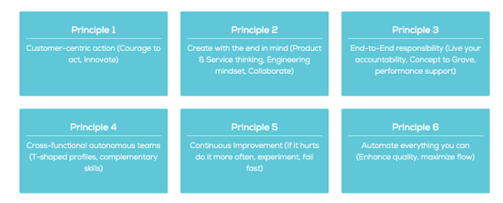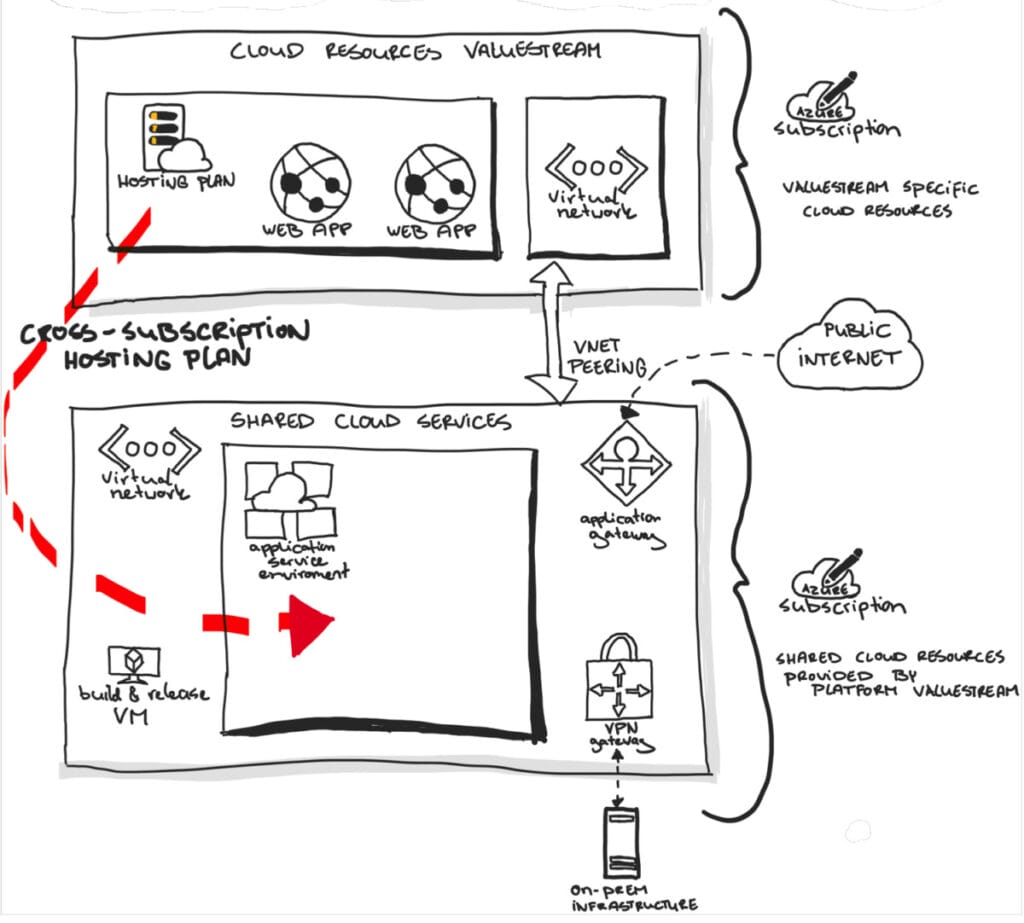Introduction
Digital transformation enables companies to realize innovations and deliver products and services with higher quality in order to exceed customer expectations (better), reduce prices (cheaper) and shorten the time-to-market (faster). However, this transformation requires organizational as well as technological changes.
In this article we will explain an organizational and platform-agnostic technology architecture that helps in realizing these digital transformation goals. The second half of the article contains an example of an implementation of this architecture on Azure.
Accelerate your DevOps adoption with the unique experience of our DevOps Bootcamp
Adopting DevOps to enable digital transformation
The keywords for achieving better, cheaper, faster products and services are flowand value, and this is what a DevOps way of working aims to achieve. To help us focus on the creation of flow and value in the delivery of products and services, we use the DASA DevOps principles as guidance (see Figure1).

Figure 1: DASA DevOps principles (source: DevOps Agile Skills Association)
These principles focus on organizations and the individuals in those organizations. They describe what actions, behavior and other aspects are required from these organizations in order to migrate to, or adopt a DevOps way of working. It would take too long to explain the principles in detail, but we will explain them briefly to be able to understand the reasoning behind the architectures described in this article. For more detailed information, please refer to the DASA website and resources.
The principles have been listed in their order of priority. The first one focuses on the creation of value for the customer, because this is a fundamental value for an organization to be able to survive in this digital age. The second principle means breaking down siloes by structuring an organization around products and services instead of processes and subject-matter expertise. The third principle is saying: “You build it, you run it” and means that you are responsible for the products and services until they cease to exist. Achieving flow in work that needs to be done and decreasing dependencies between teams and individuals is what principle number four aims to achieve. To be able to change in incremental steps, a rigorous continuous improvement process must be adopted as stated in principle five. And last but not least, improving continually also means automating everything that is repetitive when possible. By doing this, principle six aims to increase quality and maximize flow.
In order to allow teams and individuals to apply these principles they must have, or grow towards, an organization that is geared towards increasing the flow of value to the customer. In addition, they also need the technical resources to support them in this mission. In the next two paragraphs we will zoom in on the organizational and technical architectures that enable this.
Organizationally enabling DevOps teams
When looking at an organization before a digital transformation, IT plays a supporting role to the business (see the left hand side of Figure2). Business-units have a cross-backlog demand in order to get their required products and services to production. Development and operations are separated into a change and run organization among other siloed organization structures. This way of organizing has a negative impact on the optimal flow in the software delivery value chain because of organizational and technical dependencies. In addition, the siloes cause hand-over moments and loopbacks in the delivery process, which is also inefficient.

Figure 2: Organization architecture as-is and to-be
In the new situation (see right hand side of Figure 2), the teams are organized around autonomous business capabilities, which means that they can develop their products and services without disturbing, or being disturbed, by other developments. The teams are cross-functional, making them capable of developing and running their products and services until they are no longer required. Technically they are supported by a self-service (cloud) platform which enables them to rigorously automate and quickly innovate by incorporating new platform services to their offering. This is done in an incremental, continuous improvement way of working.
Technically enabling DevOps teams
In order to provide teams with the ability to operate and act according to the DevOps principles, a high and mature level of autonomy and agility is required. This poses requirements and constraints on the technical architecture, but also on the way governance and control is achieved.
DevOps teams will need to be able to have end-to-end responsibility for their value proposition and the corresponding implementation of architecture and applications. Nowadays most teams are very capable of doing this for traditional software development, focusing on delivering the application.
A digital transformation that incorporates a cloud platform presents new opportunities. The practices need to embrace a similar approach for the infrastructural part of the software solutions as well. DevOps teams are facilitated in this by a self-service cloud platform (see Figure3).

Figure 3: Self-service (cloud) platform logical architecture
Achieving full autonomy through infrastructure-as-code
Modern cloud platforms allow complete automation for provisioning the resources they offer. This automation enables a team to treat the infrastructural aspects of a software solution in the same way as the implementation of business and customer functionality. This practice of “Infrastructure as Code” creates scripts and templates in a cloud-platform specific format that is maintained, tested, and uses build and release pipelines like conventional code. This flow will allow a team to automate all aspects of the application parts they need to build and host on cloud resources. It also allows the team to continuously improve the infrastructure, because it becomes trivial to remove existing resources after changes and to reprovision them, instead of having to change and maintain previously deployed resources. A team can become completely autonomous when it is able to achieve this level of automation in cloud solutions. The team can provision and deprovision resources for these solutions as value-stream specific cloud resources (see the Cloud resources value stream A-D in Figure3).
Maintaining governance and control with full-autonomy
The biggest challenge in delivering value after adopting the full automation of infrastructure involves the governance and control over the cloud platform. A self-service cloud platform should give autonomy and agility to teams, and also provide the appropriate level of governance and control to an organization. While the team needs to be able to be agile, move fast and be independent, the organization needs to be compliant and provide traceable processes and be in control of costs and security of the cloud platform hosting.
Fortunately, cloud platforms offer various features to have this level of control while still providing self-service capabilities to the teams. The whole purpose of this approach is to enable the value stream teams to provision their own cloud resources, within the constraints offered and required by the organization. The anti-pattern to this is creating a single point in the organization, such as a team, where the teams have to request and acquire the cloud resources they need. However, having a single point of administration will block and slow down teams that want agility and speed.
The self-service cloud platform should offer cross-cutting functions (see Cross-cutting functions inFigure3) by using the cloud intrinsic features for monitoring, cost management, and security. Each cloud platform implements these features in a different manner. From a cloud-agnostic point of view, the monitoring features should allow both teams and the organization at an aggregate level to monitor the health and security of the hosted solutions. This includes resource utilization, ownership of resources, and active security status, to name a few.
Additionally, a shareable set of cloud resources can provide a layer of structure and boundaries for the teams, on top of which they can build their solutions (see the Shared Cloud Resources in Figure3). This can range from shared security features to networking topologies that make sure that certain quality and safety standards are being met automatically by the teams.
Limiting access to resources
Another aspect to consider is the use of authorization and role-based access control. Using these security aspects, it is possible to limit the rights of principals to create cloud resources or certain types thereof. In lieu of the full automation, compliance and security, one could go as far as removing all rights from regular user accounts, except read-only access. The rights to create and manage resources is only given to service principals (non-human accounts) that are assigned as the identities for build and release pipelines. This forces the use of the pipelines for resource management and disallows direct manual intervention, increasing compliancy and traceability of the cloud solution as well as the level of security. The strict authorization can be applied to all environments or at least the critical ones, for instance production. Since no human can make changes and everything is automated, approval processes can be simplified to check for the proper use of blessed templates and scripts. In time it might become apparent that approval is not even required anymore. At that point removing the approval altogether will increase the agility and speed for the value streams even further. The use of strict authorization should be applied with caution though, as it can severely limit the teams when applied too rigorously, and effectively take away the necessary privileges for a team to be able to self-service its cloud resources.
Transition to self-service with a cloud platform team
A dedicated team can help during the transition to the self-service cloud platform. This “cloud platform team” can accelerate the cross-team self-service features and functionalities. The purpose for this team is to implement the cross-cutting functions and the shared resources, as well as guidance for the teams and help during adoption and transitioning to the self-service platform. The team can create “blessed” templates and scripts for the teams to use in provisioning value stream-bound resources. These automation artifacts have been tested and security hardened to make sure the security baseline for the teams is met by default when they are utilized in provisioning build and release pipelines. The underlying shared resources give the teams the harness of enough freedom while maintaining a secure and compliant implementation for the cloud infrastructure.
The cloud platform team is a temporary team and should dedicate itself to delivering the cross-cutting and shared features, onboarding the value stream teams, and making themselves redundant.
The value stream teams can take over the responsibilities of the cloud platform team as a community effort. Since all provided features are treated like code, the way community contributions are made can work the same way for the delivered infrastructural artifacts.
In addition, they lead by example in showing the behavior and mindset that is required for the new way of working. Please note that the impact on cultural change should not be underestimated. To be successful, it can even be beneficial to add a dedicated coach to the platform team to accelerate this change.
Implementing a self-service cloud platform on Azure
The first half of this article explained what is required organizationally and technically to maximize the creation and increase of flow of value to the customer. This second half contains an example of an implementation of the technical architecture in Azure.
The Microsoft Azure platform accompanied by Azure DevOps (previously known as Visual Studio Team Services) is well suited to implement the self-service cloud platform. Azure offers advanced resource management and monitoring capabilities. Its automation engine is called Azure Resource Manager (ARM), which can be automated by using ARM templates or the Azure Command-Line Interface (CLI). Either of these allow full automation of provisioning and managing Azure resources.
At the highest level, Azure uses the notion of an enterprise and subscriptions. The enterprise is a representation of the organization that uses Azure, and its subscriptions are administrative units of ownership and rights. The subscriptions align well with the value streams, where each team can be an owner or contributor, depending on whether full or nearly full management rights are allowed. The resource management in Azure is governed by security policies at various levels. From data plane to control plane you can define authorization at a coarse and very fine grained level. By giving the teams respective rights, they can create all resources anywhere within the subscription, or within resource groups as contributors. The latter is a way to allow teams to create resources in a more controlled way, because additional permissions can be set at a resource group level. It avoids giving the teams full administrative rights to the subscription.
For the cross-cutting functions Azure has several features offering the monitoring, compliance, security and cost management capabilities required. Azure Monitor, Azure Security Centre, and Azure Cost Management are ready-to-use features that combine information gathered from and across the subscriptions for the value streams. The governance and compliance can be taken care of at this higher aggregation level. Azure DevOps, even though not part of the Azure cloud platform per se, is the single point of arranging the build and release pipelines for provisioning. It can provide the full end-to-end traceability for compliancy reasons, from code to hosting environment. Azure DevOps combines source code management with work item tracking and pipelines to environments after approval and passing quality gates. Leveraging these features allows teams to stay compliant because every change to code and environments is tracked and audited in Azure DevOps.

Figure 4: Cross-cutting functions in Azure
The next example in Figure5illustrates how shared cloud resources can be used to provide a secure default self-service cloud platform. The general idea of the scenario in the example is to allow the teams to provision web resources, while still keeping control over public availability and securing their resources. The intent is to give freedom and protect against unwanted disclosure and exposure of internal network-reachable resources.

Figure 5: Example self-service platform hybrid-architecture implemented on Azure
Each value stream and team is given their own subscription. Within these subscriptions, virtual private networks are created to isolate value streams from each other. Hosting plans are created inside the subscriptions and the team can provision web apps as they see fit. The design of these web apps does not allow any outbound connectivity. This avoids exposing anything immediately after creation and provides a secure, default approach.
To be able to release web applications for the first time, changes need to be made at the shared resources level. While this is blocking to some extent, it does provide control in terms of which web application is allowed access to the public internet and when. This provides an opportunity to make sure that only approved and validated web resources are disclosed. It only has to happen once during the initial release, so it should not be a big nor lasting hurdle in the value stream flow. The technical implementation for retaining access over public facing web applications is the Web Application Firewall and Gateway. This Azure resource has to be configured so that it allows inbound and outbound HTTP and HTTPS traffic, all by automated scripts, and obviously after approval. By keeping this resource at a shared and governed level, the organization retains its ability to have control over web-exposed solutions, while giving the teams freedom to create any resources up to the point that they need to be released externally.
One other security measure in the example is the use of Application Service Environments (ASE). The scenario shows connectivity to an on-premise infrastructure via a Virtual Private Network (VPN) Gateway. It is non-trivial to create a VPN tunnel to on-premises networks. Keeping the connection at a shared resource level makes it reusable over the various value streams and teams, in addition to providing a single point of entry into the on-premises network. The VPN Gateway provides another control mechanism for securing access to the on-premises resources by specifying advanced access rules for allowed network traffic to and from it. Each value stream Virtual Network is given a peering to the shared virtual network that includes the VPN and Web Application Gateways.
The shared resources are created by the initial cloud platform team, which behaves and operates like any of the other value streams. While the team still exists, it provides a different value stream, consisting of the self-service platform’s shared resources for the other teams and value streams to utilize. In a similar fashion, the underlying VNETs and peerings are also not created by the teams themselves, but by the platform team instead.
Summary
Companies with the aim to deliver better and cheaper products and services in a faster way need to make a digital transformation. They should adopt or migrate to a DevOps way of working to increase the flow of value to the customer. To achieve this, organizational and technical changes are required to enable teams and individuals. A temporary cloud platform team can help to make the transformation happen. The technical resources can be implemented in Azure, as shown in the example of a self-service platform in Azure. When both aspects (organization and technique) are applied incoherence, a company’s teams and individuals are lined up to achieve the digital transformation goals.
Accelerate your DevOps adoption with the unique experience of our DevOps Bootcamp





